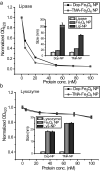Colorimetric protein sensing using catalytically amplified sensor arrays
- PMID: 22961696
- PMCID: PMC3514658
- DOI: 10.1002/smll.201201549
Colorimetric protein sensing using catalytically amplified sensor arrays
Abstract
Catalytically active iron oxide nanoparticles are used as recognition elements and signal amplifiers for the array-based colorimetric sensing of proteins. Interactions between cationic monolayers on the Fe(3) O(4) NPs and analyte proteins differentially modulates the peroxidase-like activity of Fe(3) O(4) NPs, affording catalytically amplified colorimetric signal patterns that enable the detection and identification of proteins at 50 nM.
Copyright © 2012 WILEY-VCH Verlag GmbH & Co. KGaA, Weinheim.
Figures



References
-
- Mullenix MC, Wiltshire S, Shao WP, Kitos G, Schweitzer B. Clin. Chem. 2001;47:1926–1929.
-
- Kingsmore SF, Patel DD. Curr. Opin. Biotechnol. 2003;14:74–81. - PubMed
-
- Okuno J, Maehashi K, Kerman K, Takamura Y, Matsumoto K, Tamiya E. Biosens. Bioelectron. 2007;22:2377–2381. - PubMed
-
- Anderson NL, Anderson NG. Mol. Cell. Proteomics. 2002;1:845–867. - PubMed
-
- Hartwell L, Mankoff D, Paulovich A, Ramsey S, Swisher E. Nat. Biotechnol. 2006;24:905–908. - PubMed
Publication types
MeSH terms
Substances
Grants and funding
LinkOut - more resources
Full Text Sources

